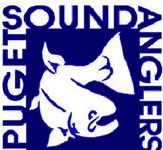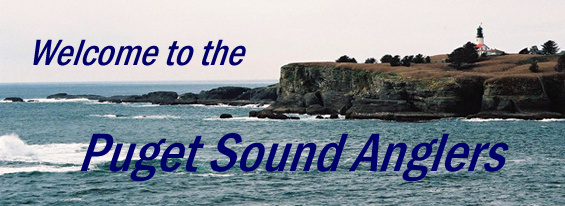|




 
 |
Hood Canal
Chinook & Coho Fishing
When:
This fishery is divided into basically 3 different fisheries. The
southern section below the Ayock Point
47-30-217 123-03-019
east -west line is the first to open usually on July 1. Quilcene/Dabob Bay
is next opening usually August 16th, with the upper section from Ayock
point to the Hood canal floating bridge opening September 1.
Lower Hood Canal
salmon fishery opens July 1, but the fish are usually not there yet, so
fishing will usually start about August 1, but not get into full swing until
about the middle of the month. The Chinook will be the first to show. The
weather & water temperature will have some bearing as to how early they
start coming in. There needs to be some rain to slightly cool the water &
provide a slight flush to get things into full swing. So if there are a few
days of rain the first week or so of August, you may consider getting on the
water.
On the odd years, by the end
of July or the 1st week of August, there is usually a run of Pink salmon in
the canal. These fish tend to stay close to the shoreline. when they are
in, you can usually see them finning on the surface.
The Ayock point cut
off is to protect endangered fish from some of the upper rivers. After
these fish have entered their respective rivers, the upper canal will be
opened. There is a great Coho fishery in DaBob Bay later in September when
the hatchery fish return. This fishery is north of a true east line from
Point Whitney to the Toandos Peninsula. Daily limit is 4 Coho, with the
Handling Rule in effect for all species of salmon except Coho.
Where to Fish:
The area north of Ayock Point
is closed for salmon fishing until September 1. These fish have to move
down, (south) from the entrance of the canal, so early, like the first part
of August, you need to target them nearer the northern boundary. The fish
entering the canal will of course be found migrating south, so where they
were a week ago may not be where that school is tomorrow. Once the rains
start & more fish begin entering their home water, the schools may well
blend into fish being found spread out in more locations.
A good starting
point below that location for Chinook, for you to target would be off the
mouths of any of the small rivers that empty into the canal. Later in the
season Coho can be found here also, but when they are in, about anywhere,
even in the middle of the canal seems to produce. The word from some of the
old timers there is that the Chinook tend to follow the west shore, while
the Coho will use the east shore more.
Trolling depth is the real
question, & for the single person in a boat you are handicapped, as the more
rods out at different depths, the better chance you have to locate the hot
spot. Do not expect to locate many fish in the sonar, as if they are not
concentrated, you will not see then unless by chance. In the morning, I
would tend to fish shallow & near the shore, say 25' deep in 30' - 40' of
water. As the sun comes up, the fish will move out & deeper. The depth
most fish seem to be caught appear be from 40' - 80' deep & in water of
depths of 75' - 135'.
In the chart below
the better fishing areas are highlighted in yellow, the boat launches are
green. The red are marine closures & the orange are possible crab
locations. The red horizontal line would be the early boundary at Ayock
Point. On the upper or north of this chart on the west shore, will be
Trident Cove State Park which has a public launch.
|
Lower Hood Canal |
Upper Hood Canal |
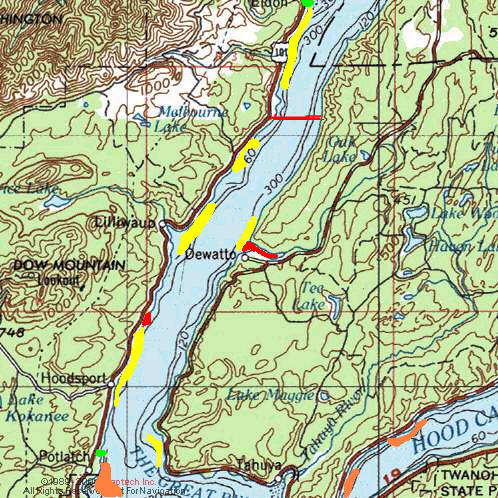 |
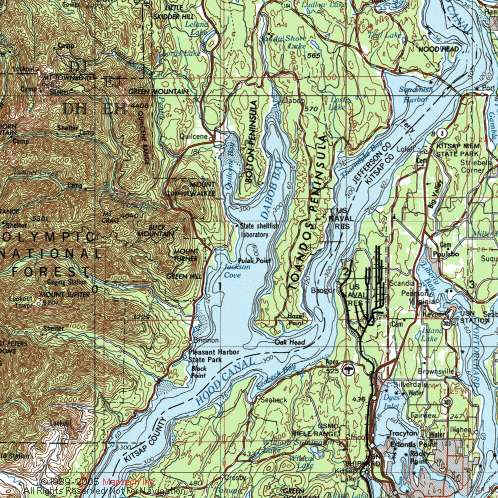 |
Where to Launch:
One thing common with most launches here is that the water off the shores are
not deep & there is usually a problem launching or reloading at a low tide.
There few to choose from in this area, but the main ones will be as follows.
(1) Hood Canal Saltwater Park is across the
road from the Tacoma Public Utilities powerhouse & operated by the Skokomish
Tribe. A new one (August 2006), 2 lane concrete ramp with lots of gravel
parking, with the preparation area on the north side of the ramp. During the
peak fishing times it can become full. No loading dock, but a decent gravel
shore on both sides of the launch to beach the boat on. Well maintained
public restrooms open at 8:00AM (due to vandalism). Large picnic areas around
the perimeter of the parking area are available also.
(2) There are a couple of private launches on the west side of the canal, one
being at Mike's Beach Resort about 15 miles north of Hoodsport. This one you
have to let him back your boat in with his jeep that he has a hitch on the
front. And a low tide may be a hindrance.
(3) There is a sling at Rest-A-While campground, but not usable at a low tide.
(4) Trident Cove State Park is located on the west shore about 19 miles
north of Hoodsport. It is a wide single lane concrete ramp with a dock. The
paved parking area is up on the same level as the Hiway, while there is a road
from there down the hill to the launch area. There is a picnic area. $5 launch
fee
(5) Union Ramp, operated by Mason County. A 2 lane concrete ramp with no dock,
that is immediately West of the Hood Canal Marina. Very limited parking.
(6) Twanoh State Park. This launch has a 2 lane concrete ramp with 2 loading
docks, however the Parks Dept. may pull docks for the winter by the time Chum
are in. No water off the concrete ramp at a minus tide & don't try to back out
on the gravel, as it is soft. Plenty of paved parking. There is a
picnic area. $5 launch fee.
(7) Seabeck Marina on the east shore has a sling.
(8) Misery Point single concrete public launch is maintained by WDFW on the east
shore south of Seabeck at the end of the Miami Beach Rd.
(9) The launch near Quilcene
operated by the Port of Port Townsend is a single lane concrete ramp with a
floating dock.
(10) There is another launch at
Point Whitney shellfish lab, but it is recommended for use with 4 wheel drive
vehicles only as there is lots of gravel on the ramp.
(11) Salsbury Point park on the east shore just north of
Hood Canal bridge. It has a double concrete ramp with a dock between.
|
Hood Canal Saltwater Park at
Potlatch, 2004 |
Off the lower end of the "New"
Hood Canal Saltwater Park at Potlatch, 7-14-07 2007 10:30AM with a
3'- at noon |
 |
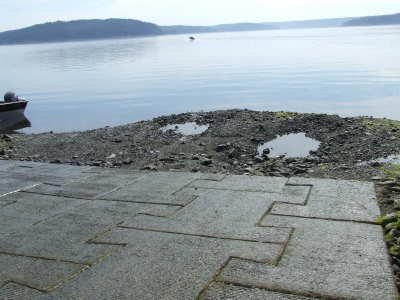 |
|
Union launch at a 1.5'
minus tide |
Twanoh
State Park launch |
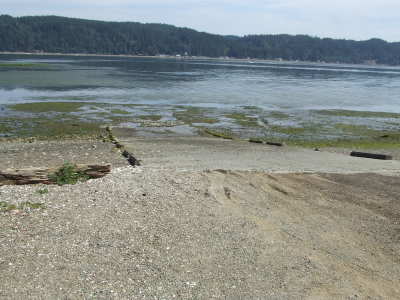 |
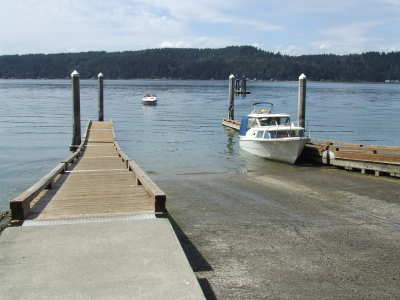 |
|
Twanoh
State Park at a 3' minus
tide |
Salsbury Point Park |
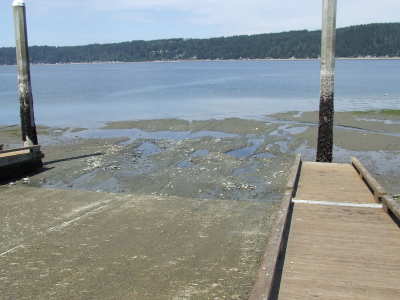 |
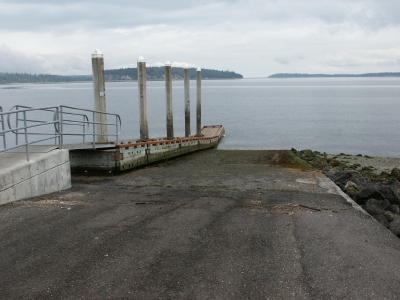 |
Method: If you ask 20 fishermen their preferred method,
you will get at least 20 different answers. Here we will give a some methods &
you can choose what fits you. One thing here is that they usually are not deep,
as recent years the dissolved Oxygen is very low as this body of water is dead
ended, with no large rivers flowing into it from the southern end, to the point
the WDFW has closed taking of any bottomfish. With this in mind, the salmon
will tend to not go deep, as they will have problems breathing. A fishing depth
will usually be from 35' to 40', in water up to 150' deep. There is no need to
go out in the middle & try to go deep at the 400' depths. Trolling with
downriggers is probably the most common method, with trolling with divers next &
jigging following that.
Trolling for Chinook: This area does not have to be fished
with downriggers, however if you have them & are used to using them, go for it.
For Chinook, one local "expert" uses a 4oz kidney sinker, 30" of 30# mono to a
Sliver Horde Double D #10 flasher, then the lure may be a Coho killer, Coyote
spoon in Army Truck, Wonder Bread or glo green/white. Occasionally he will use
a FST spoon or he has been known to scrounge yard sales for peal wobblers in 1
1/2" to 2". These spoons are tied to a leader 2 1/2 times the length of the
flasher. Speed will be adjusted from 1.5 to 2.3 mph or so the flasher will just
rock back & forth. He fishes shallower than most, in that he only fishes
20-30' deep in 30-50' of water.
Using the above information, a person without downriggers is
not handicapped here, as a Deep Six diver would get you down & perform quite
well especially if you troll in 25' or 30' of water near shore.
At times there may be a considerable number of Jellyfish
here. You may also encounter floating weeds, especially during a maximum tidal
exchange as when a -1.5' + low tide occurs. Normally the weeds are not a
serious problem, the exception is the photo below.
| In
this photo, some of the weeds had already fallen off before the
camera was grabbed. |
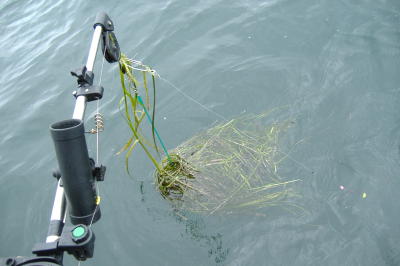 |
One thing that has been observed, is that most of the time
this water is warm. I observed the temperature at a high tide in the middle of
August at 65 degrees & at 70 degrees a the the low part of the outgoing
tide. Later when there was a rain the temp went down to 58 degrees. The fish
may tend to drift into deeper water to find a more comfortable zone. But in
doing so, they tend to become lethargic because of the low dissolved Oxygen in
the water. What this means to you as a fisherperson, is that IF you have to
follow the dethfinder's fish, you then may have to slow your speed down. As
these fish being in the lower dissolved Oxygen layer, are slowed down & you then
will need to present the lure in a slow enough fashion so that if it is close
enough to them, that they have enough time to consider taking the lure.
These fish also tend to darken up some even after just a few
days in the canal, possibly because of the water temperature.
Another observation is that when these fish show, they appear
to react similar to the estuary fish, in that the bright "new" fish that come
in, tend to be the biters. I believe that once the fish get in any body of
water on their return trip to the home stream, that they get acclimated & then
they do not bite anywhere near like fresh fish to the area. The fresh fish seem
to bite the normal tackle.
As these fish extend their stay, then it may be best to
switch from trolling gear to jigging. So it may behoove you to be sure that you
have a few jigs in your salmon tackle box, even though you are not a jigger, as
if they are not biting trolling it may save the day, instead of giving up &
going home early. If you happen to find a considerable number of fish in a
particular area but can not entice them to bite while trolling, all the more
reason to consider switching over to jigging as described below.
Jigging from a boat: When jigging, you will need a good
fishfinder. Locate some fish & stay jigging with them if they move. Point
Wilson Darts in a 3.5" size, Buzz Bombs & Grim Reapers seem to be the lure of
choice for many. I have seen some jiggers jerking the whole rod considerably
high in the air, moving the jig probably 6' at a time. These people either have
the wrong rod, have been taught wrong, or are deliberately snagging. The rod
needs to be a medium heavy but with a fast taper on the tip, otherwise you are
going to wear yourself out moving the whole rod a lot but the lure is only
moving a little.
Some fisherpersons will drift with the tide/wind while
others, especially if near the hatchery, will anchor & cast toward what they
perceive as possible schools of fish.
Some may try to use Buzz Bombs from the shore or a dock,
which can be effective, as these fish tend to stay close to the shores, as
evidenced by some of the Skokomish Indian gillnets near shore & their use of
beach seines.
The year 2003, I was doing the south weigh in for South
Sound PSA salmon derby at Sunrise Beach Resort's dock in the middle of August.
This was just north of the Hoodsport hatchery. I observed a couple of young men
jigging out of a new 14' aluminum boat. They were doing it right, in that the
rod tip was lowered, & given an upward twitch, reeled in a few cranks & the
process repeated. In the 2 days I was there, I personally saw them bring in 2
fish over 25#. Of course they were not entered in the derby. The first day
they even had to borrow a landing net.
Casting from the
Beach at the Hatchery: This is something that everyone should
at least observe. You can park & walk thru the hatchery parking lot & past the
ponds to the SW corner of the hatchery. From here you can walk the "cat walk" &
climb down to the beach. WDFW regs state that no fishing can be done from the
actual hatchery property. Finch Creek flows along the south edge & then past
the hatchery & is used for the water in the hatchery, so these fish are
imprinted to return here. The creek out into the canal is narrow, 20' & shallow
6". If the fish are there & wanting to return to the hatchery, on an incoming
tide of about 1/2 way in, they will be in schools just off the beach. They will
swim up the creek to the hatchery, (about 100 yards). The creek is so shallow,
part of the fish will be out of the water & as they wriggle up the creek, you
can see this commotion from some distance.
These fisherpersons can be dressed in normal clothing & just
stand on the beach at a low tide, or from those that are using chest waders & in
water up to their chest when the tide is in. They may tend to wait until they
see a fish jump or roll & then cast toward it. The lures are usually a 1/4
ounce lead sinker tied onto the end of the line, & then a leader of about 36" to
a orange corkie about 1/2" dia. with a single hook & red or green yarn
attached. The regulars there tend to discourage those who may show up with a
spinner, saying that it spooks the fish when cast into that shallow water. Some
of the fishers who wade out farther may use Buzz Bombs of about 3 1/2" size.
The rules appear to be that you CAN fish the salt water, but
NOT the freshwater of the creek. However as the tide comes in the creek soon
becomes saltwater.
|
Chinook Salmon coming up the creek Aug 22
2004 A line of fisherpersons off the hatchery |
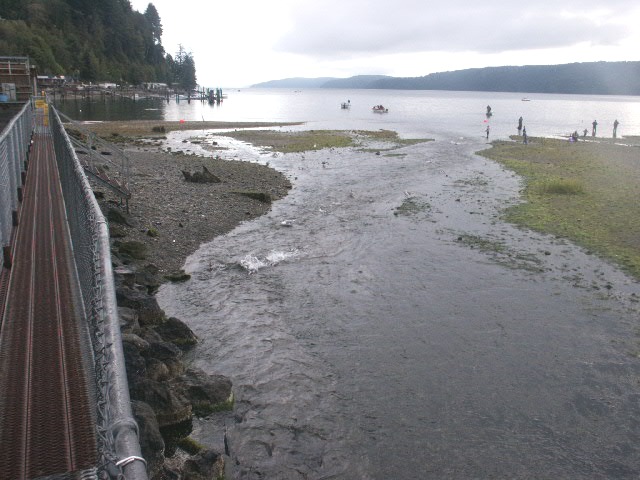 |
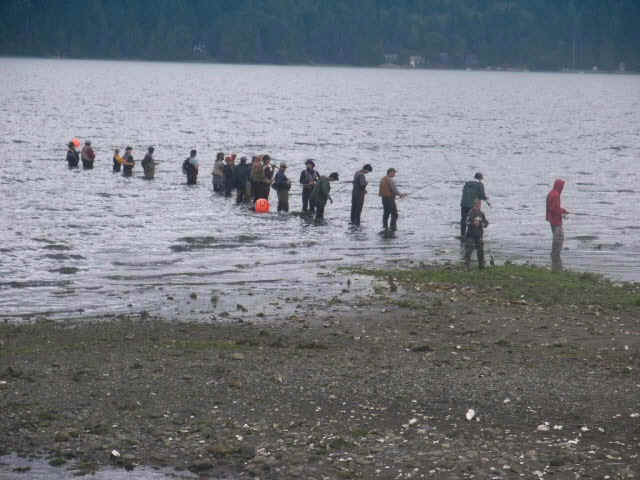 |
Tackle for Coho: The Coho will start showing about the end
of August, with September being considered about the best time depending on the
weather, but still into October can be good.
Some of the Chinook lures will also work for these fish, but
you may want to consider changing to a redish orange Wriggle Wart, Spi-N-Glo or
any of the more typical Coho lures. If you do go to the Wriggle Warts, then
remove the triple hooks & replace them with a single Siwash. You will get more
fish into the boat, in that it seems that the triple hooks tend to not get
hooked as good & when the fish is fighting, will pull out easier.
Seals: These furry creatures can be a problem at times.
One solution is to have a strong enough mainline, 25#, & a 30# + leader so that
if the seal takes your fish, you can run the boat right over the top of him &
keep above him. He can not eat the fish under water. He will have to
eventually come up for air. When he does you can most likely get your fish
back. One key thing here is to this is to use the newer bright colored line.
This will help you see where the line is going toward the seal. Maybe for you
younger people a regular colored line way be OK, but just wait until you get
older & join the Mouldy Old Foggy club.
Copyright © 2004-2009 LeeRoy Wisner All Rights Reserved
Originated 8-15-04, Last updated 1-06-2006
to
contact the author click here
|
|
Home
About
Us Fishing
Politics
Conservation
Photos
Contact
Us |
